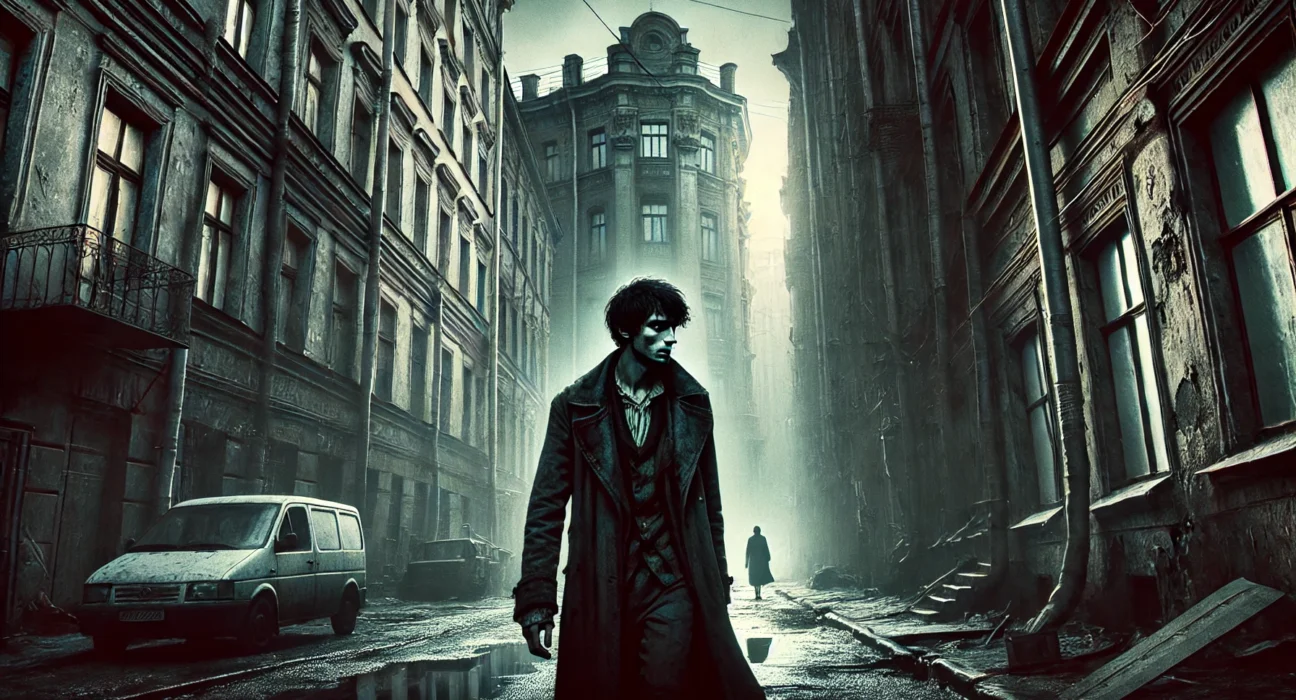“Crime and Punishment,” written by Fyodor Dostoevsky and first published in 1866, is a seminal work of Russian literature. This psychological drama delves into the moral dilemmas and existential crises of its protagonist, Rodion Raskolnikov, a destitute former student in St. Petersburg. The novel explores themes of guilt, redemption, and the interplay between good and evil, set against the backdrop of 19th-century Russian society.
Comprehensive Plot Summary
On a sweltering July evening, Rodion Raskolnikov, a former student mired in poverty, steps out of his cramped garret and wanders the grim streets of St. Petersburg. His mind is a tempest of thoughts, and he contemplates a chilling act he has been mulling over for months: the murder of Alyona Ivanovna, a miserly old pawnbroker. He rationalizes that ridding the world of such a parasitic creature would serve humanity and justify the theft of her money, which he plans to use for good deeds.
That fateful day, Raskolnikov visits Alyona with an old watch to pawn, confirming she is alone in her apartment. He returns later, his heart pounding with a mix of dread and determination. With an axe concealed in his coat, he brutally bludgeons Alyona to death. To his horror, her half-sister Lizaveta walks in unexpectedly and, in a panic, he kills her too. Shocked by his own actions, he hastily gathers a few valuables and flees the scene, narrowly avoiding detection.
In the ensuing days, Raskolnikov’s mental state unravels. Feverish, paranoid, and consumed by guilt, he withdraws further into himself. His erratic behavior draws suspicion, particularly from the astute detective Porfiry Petrovich, who employs psychological tactics to unsettle him. Raskolnikov’s internal conflict intensifies as he wrestles with his sense of guilt and his philosophical justifications for the murder.
Amidst this turmoil, Raskolnikov encounters various characters who influence his troubled psyche. Marmeladov, a drunken clerk, recounts his own family’s dire plight, leading Raskolnikov to meet Sonia, Marmeladov’s virtuous daughter, who has turned to prostitution to support her family. Sonia’s unwavering faith and kindness become a source of both torment and solace for Raskolnikov. He is drawn to her suffering and her ability to endure it with grace, contrasting sharply with his own inner torment.
Raskolnikov’s interactions with his family add to his emotional burden. His mother, Pulcheria Alexandrovna, and sister, Dunya, arrive in St. Petersburg, bringing a mix of comfort and distress. Dunya is pursued by the manipulative Luzhin, whom she eventually rejects, causing further tension. Razumikhin, Raskolnikov’s loyal friend, provides a semblance of stability and hope, growing close to Dunya and supporting the family.
The investigation into the murders looms over Raskolnikov, with Porfiry Petrovich closing in. During a cat-and-mouse game, Porfiry hints at his suspicions but lacks concrete evidence. Raskolnikov’s mental anguish reaches its peak as he oscillates between feelings of invincibility and profound guilt. His encounters with Sonia become increasingly significant. She urges him to confess, believing that redemption lies in repentance and suffering.
A turning point occurs when Raskolnikov meets Svidrigailov, a morally bankrupt man who harbors dark intentions towards Dunya. Svidrigailov’s suicide after a series of revelations forces Raskolnikov to confront the futility and destructiveness of his own philosophy. He realizes that his actions have not set him apart as an extraordinary man but have only deepened his misery and isolation.
In a moment of clarity, Raskolnikov confesses his crime to Sonia. Her unwavering support and belief in his potential for redemption lead him to turn himself in to the authorities. He is sentenced to Siberian penal servitude, where Sonia follows him, embodying the hope and compassion he needs to begin his journey toward spiritual awakening.
In the harsh environment of the Siberian prison, Raskolnikov grapples with his past actions and their moral implications. The suffering and isolation of the penal colony serve as a crucible for his transformation. Sonia’s visits and her steadfast faith provide a lifeline, gradually breaking down his emotional barriers. Her belief in his capacity for goodness kindles a spark of hope within him.
Through the course of his imprisonment, Raskolnikov’s heart slowly opens to the possibility of redemption. He begins to understand the value of Sonia’s selfless love and the strength it takes to endure suffering with grace. The journey is arduous, marked by moments of despair and introspection, but the seeds of change take root. Raskolnikov starts to see beyond his own pain and guilt, recognizing the humanity in those around him and in himself.
The transformation is neither swift nor easy, but it is genuine. As Raskolnikov accepts his suffering and acknowledges the wrongs he has committed, he starts to rebuild his sense of self. The path to redemption is fraught with challenges, yet it offers a glimmer of a new beginning. In the end, Raskolnikov’s story is one of profound moral and spiritual awakening, a testament to the enduring power of compassion, repentance, and the human capacity for change.
Main Characters
- Rodion Raskolnikov: A former student plagued by poverty and a grandiose sense of superiority. His internal conflict and moral dilemmas drive the narrative.
- Sonia Marmeladov: A meek and devout young woman forced into prostitution to support her family. She becomes Raskolnikov’s confidante and moral compass.
- Porfiry Petrovich: The shrewd and psychologically astute detective who suspects Raskolnikov and uses psychological tactics to unnerve him.
- Dunya Raskolnikov: Raskolnikov’s loyal and determined sister, whose relationships add to his emotional turmoil.
- Razumikhin: Raskolnikov’s friend who provides support and represents the possibility of a normal, honest life.
- Marmeladov: A tragic, drunken clerk whose story intersects with Raskolnikov’s and highlights themes of suffering and redemption.
- Svidrigailov: A morally corrupt man whose actions and eventual suicide serve as a catalyst for Raskolnikov’s realization of his flawed philosophy.
Themes and Motifs
- Guilt and Redemption: Raskolnikov’s journey is a profound exploration of guilt and the possibility of redemption through suffering and confession.
- Crime and Punishment: The novel delves into the psychological and moral consequences of crime, extending beyond legal punishment to inner torment.
- Isolation and Alienation: Raskolnikov’s sense of isolation is both a cause and consequence of his actions, highlighting the human need for connection and empathy.
- Moral Ambiguity: The characters and their actions are steeped in moral ambiguity, challenging the reader to ponder the nature of good and evil.
- Sacrifice and Suffering: Sonia’s sacrifices and the suffering of various characters underscore the novel’s exploration of compassion and spiritual awakening.
Writing Style and Tone
Dostoevsky’s writing style in “Crime and Punishment” is characterized by its intense psychological depth and complexity. He employs a third-person omniscient narrative that delves deeply into the minds of the characters, particularly Raskolnikov. The narrative is often fragmented, reflecting Raskolnikov’s tumultuous mental state. Dostoevsky’s use of interior monologue and stream of consciousness techniques allows readers to experience the protagonist’s inner conflicts and moral dilemmas intimately.
The tone of the novel is dark and foreboding, with a pervasive sense of tension and unease. Dostoevsky masterfully creates an atmosphere of psychological suspense, where the reader is constantly aware of Raskolnikov’s inner torment and the looming consequences of his actions. The bleak and oppressive setting of St. Petersburg enhances this tone, mirroring the protagonist’s mental and emotional state. Despite this darkness, the novel also contains moments of profound human compassion and the possibility of redemption, providing a glimmer of hope amidst the despair.
If this summary has sparked your interest, we would appreciate you subscribing to our newsletter.
There’s a treasure trove of other fascinating book summaries waiting for you. Check out our collection of stories that inspire, thrill, and provoke thought, just like this one by clicking here.
If you want to request a book summary, click here.
When Saurabh is not working/watching movies/reading books/traveling, you can reach him via Twitter/X, or LinkedIn.
Restart reading!






